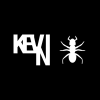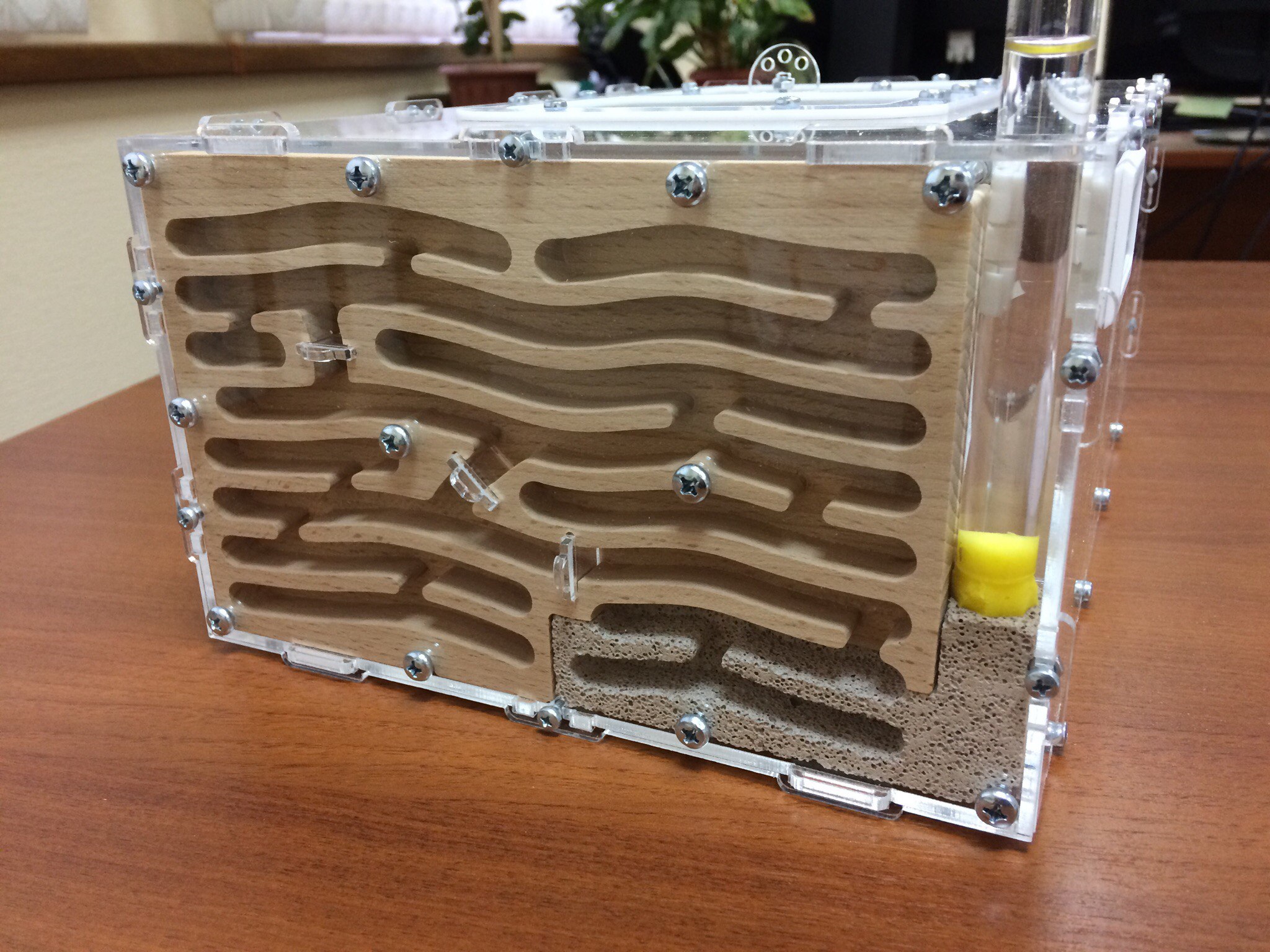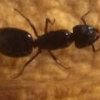- Formiculture.com
- Forums
- Gallery
- Members
- Member Map
- Chat

Two brothers ACFK-4 and AWFK-4
Started By
antsrussia
, May 23 2017 8:38 PM
54 replies to this topic
#21
 Offline
-
Posted May 24 2017 - 4:33 PM
Offline
-
Posted May 24 2017 - 4:33 PM
I've kept 4 species of ants in bone dry (50% RH technically) nests with water sources; they thrived. It comes done to their species and subsequent desiccation resistance. It's mostly the brood that require water, and the workers collect it specifically to give their larvae. The species were: Camponotus floridanus, Pseudomyrmex gracilis, Crematogaster pinicola, and Colobopsis impressa. A nest such as the wooden one would suit them well.
#22
 Offline
-
Posted May 24 2017 - 8:21 PM
Offline
-
Posted May 24 2017 - 8:21 PM
Thanks for all your feedback and advice.
We made it according to the experience of other keepers, which contain camponotus in wooden nests.
Edited by antsrussia, May 24 2017 - 8:21 PM.
#23
 Offline
-
Posted May 24 2017 - 9:17 PM
Offline
-
Posted May 24 2017 - 9:17 PM
Amazing! Never knew camponotous could live in a nest without humidity. I will have to build a wooden nest and give it a go one of these days.
#24
 Offline
-
Posted May 25 2017 - 2:51 AM
Offline
-
Posted May 25 2017 - 2:51 AM
I've kept 4 species of ants in bone dry (50% RH technically) nests with water sources; they thrived. It comes done to their species and subsequent desiccation resistance. It's mostly the brood that require water, and the workers collect it specifically to give their larvae. The species were: Camponotus floridanus, Pseudomyrmex gracilis, Crematogaster pinicola, and Colobopsis impressa. A nest such as the wooden one would suit them well.
What I am trying to say is yes, they can survive, although it's not nessasarily good to have workers do the extra job of carrying water to the nest. It is also unnatural and appears incorrect to not hydrate a nest. Maybe it works for you to put your species in unsafe conditions, but there are also other nests out there for all ants that do similar things like I said, and that is certainly a bad idea.
Hit "Like This" if it helped.
#25
 Offline
-
Posted May 25 2017 - 3:49 AM
Offline
-
Posted May 25 2017 - 3:49 AM
All these species routinely nest in dry hardwood. If anything, subjecting them to even a remotely moist nest is unnatural. I kept a Camponotus floridanus colony in nothing but acrylic boxes and they reached 800 workers in their first year.What I am trying to say is yes, they can survive, although it's not nessasarily good to have workers do the extra job of carrying water to the nest. It is also unnatural and appears incorrect to not hydrate a nest. Maybe it works for you to put your species in unsafe conditions, but there are also other nests out there for all ants that do similar things like I said, and that is certainly a bad idea.I've kept 4 species of ants in bone dry (50% RH technically) nests with water sources; they thrived. It comes done to their species and subsequent desiccation resistance. It's mostly the brood that require water, and the workers collect it specifically to give their larvae. The species were: Camponotus floridanus, Pseudomyrmex gracilis, Crematogaster pinicola, and Colobopsis impressa. A nest such as the wooden one would suit them well.
My point is nests with no standing water in them work for many species, and some may even require them to thrive. RH plays a big part in all of this. No one is insinuating ants would do even remotely well below 30% RH.
Edited by 123LordOfAnts123, May 25 2017 - 3:55 AM.
#26
 Offline
-
Posted May 25 2017 - 4:12 AM
Offline
-
Posted May 25 2017 - 4:12 AM
There is a huge and fundamental difference between natural nests in wood, where the wood is in contact with the (moist) ground and also exposed to the elements, versus a bone-dry captive setup.
In experimenting with wooden nests of my own design, I've found that if the wood dries out, Camponotus will scatter the eggs and larvae about as opposed to grouping them into clumps. The brood in dry nests also take on a more shriveled and dessicated appearance, versus if the wood is moistened somewhat. Consequently, it is absolutely essential, in my view, that the user be able to regulate the relative humidity inside the nest where eggs and larvae are kept. This is especially critical in drier climates like southern California, where the air itself sucks away moisture very quickly.
While it may not be necessary to wet the wood itself, bone-dry wood kept indoors is most definitely a suboptimal nest medium, based on my observations and research. Unless the formicarium is kept in a greenhouse, any indoors area will naturally experience periods of low relative humidity, which could easily spell disaster for ants kept in a bone-dry nest such as this.
In experimenting with wooden nests of my own design, I've found that if the wood dries out, Camponotus will scatter the eggs and larvae about as opposed to grouping them into clumps. The brood in dry nests also take on a more shriveled and dessicated appearance, versus if the wood is moistened somewhat. Consequently, it is absolutely essential, in my view, that the user be able to regulate the relative humidity inside the nest where eggs and larvae are kept. This is especially critical in drier climates like southern California, where the air itself sucks away moisture very quickly.
While it may not be necessary to wet the wood itself, bone-dry wood kept indoors is most definitely a suboptimal nest medium, based on my observations and research. Unless the formicarium is kept in a greenhouse, any indoors area will naturally experience periods of low relative humidity, which could easily spell disaster for ants kept in a bone-dry nest such as this.
Edited by drtrmiller, May 25 2017 - 4:15 AM.
- Kevin and Cameron C. Thomas like this
byFormica® is the manufacturer of the iconic nectar feeders and Sunburst Ant Nectar.
byFormica ant products always deliver consistent performance, convenience,
and reliability, making them among the most beloved ant foods and kit enjoyed by
ant keeping enthusiasts worldwide. For more information, visit www.byFormica.com.
#28
 Offline
-
Posted June 1 2017 - 7:09 AM
Offline
-
Posted June 1 2017 - 7:09 AM
Gives an option for the colony to live in a humid area. I like it!
- Martialis likes this
#29
 Offline
-
Posted June 1 2017 - 7:21 AM
Offline
-
Posted June 1 2017 - 7:21 AM
I agree with T.C. I would feel way more comfortable being able to accommodate humidity levels in the nest.
Keeper of:
Prenolepis imparis (4 founding queens)
Camponotus pennsylvanicus (5 founding queens)
Reticulitermes flavipes (3 pairs, subterranean termite)
#30
 Offline
-
Posted June 1 2017 - 8:02 AM
Offline
-
Posted June 1 2017 - 8:02 AM
Those nest are beautiful!
I agree with T.C and Myrmidon.
I agree with T.C and Myrmidon.
Keeper of:
1x Camponotus herculeanus
1x Camponotus sylvaticus
1x Formica cinerea
1x Formica fusca
1x Formica lemani
1x Lasius flavus
2x Lasius niger
#31
 Offline
-
Posted June 1 2017 - 11:10 AM
Offline
-
Posted June 1 2017 - 11:10 AM
That is a million times better now. Goodluck selling those, they look amazing.
Hit "Like This" if it helped.
#32
 Offline
-
Posted June 1 2017 - 12:12 PM
Offline
-
Posted June 1 2017 - 12:12 PM
If only they weren't 90$ plus shipping from russia
Visit us at www.canada-ant-colony.com !
#33
 Offline
-
Posted June 1 2017 - 12:44 PM
Offline
-
Posted June 1 2017 - 12:44 PM
If only they weren't 90$ plus shipping from russia
Yeah I know right? I am outraged that they expect people to pay for their "expertise" and "equipment" to manufacture something that most can't manage on their own? Who do they think they are—a business!?
- Ants4fun, Herdo, Kevin and 1 other like this
byFormica® is the manufacturer of the iconic nectar feeders and Sunburst Ant Nectar.
byFormica ant products always deliver consistent performance, convenience,
and reliability, making them among the most beloved ant foods and kit enjoyed by
ant keeping enthusiasts worldwide. For more information, visit www.byFormica.com.
#34
 Offline
-
Posted June 2 2017 - 12:42 AM
Offline
-
Posted June 2 2017 - 12:42 AM
I too have learned that many species don't need direct contact with water in the nest, especially Camponotus. It's humidity that they need. I have some Novomessor cockerelli (a desert species) in one of my prototype formicariums, and even after greatly reducing the amount of moisture in the nest, they still prefer housing most of their colony and brood in the outworld. My Veromessor pergandei (another desert species) don't like their nest all that much until it runs out of water. Once dry, the entire colony packs into it.
If only they weren't 90$ plus shipping from russia
Yeah I know right? I am outraged that they expect people to pay for their "expertise" and "equipment" to manufacture something that most can't manage on their own? Who do they think they are—a business!?
The nerve of people trying to be paid for their work!
#35
 Offline
-
Posted June 2 2017 - 1:54 AM
Offline
-
Posted June 2 2017 - 1:54 AM
If only they weren't 90$ plus shipping from russia
Yeah I know right? I am outraged that they expect people to pay for their "expertise" and "equipment" to manufacture something that most can't manage on their own? Who do they think they are—a business!?
I'm new to this community, but I can already tell you're a little salty around the edges. It's entertaining.
- Jash, Martialis, T.C. and 3 others like this
#36
 Offline
-
Posted June 2 2017 - 2:33 AM
Offline
-
Posted June 2 2017 - 2:33 AM
This place would be much too bland without a little salt.
- T.C., Flubby100 and Cameron C. Thomas like this
#37
 Offline
-
Posted June 2 2017 - 6:26 AM
Offline
-
Posted June 2 2017 - 6:26 AM
A "little" salt is good, assuming it's not so much your choking on it. 
- Martialis likes this
#38
 Offline
-
Posted June 2 2017 - 6:29 AM
Offline
-
Posted June 2 2017 - 6:29 AM
THE ANT CZAR OF RUSSIA HAS DECREED THAT HE ENJOYS SALT!

"I'm the search bar! Type questions into me and I'll search within the forums for an answer!"
#39
 Offline
-
Posted June 2 2017 - 6:38 AM
Offline
-
Posted June 2 2017 - 6:38 AM
deleted.
Edited by Martialis, June 2 2017 - 6:40 AM.
Spoiler
#40
 Offline
-
Posted June 2 2017 - 10:01 PM
Offline
-
Posted June 2 2017 - 10:01 PM
The ytong insert in the wooden nest is more appealing to me.
1 user(s) are reading this topic
0 members, 1 guests, 0 anonymous users



























